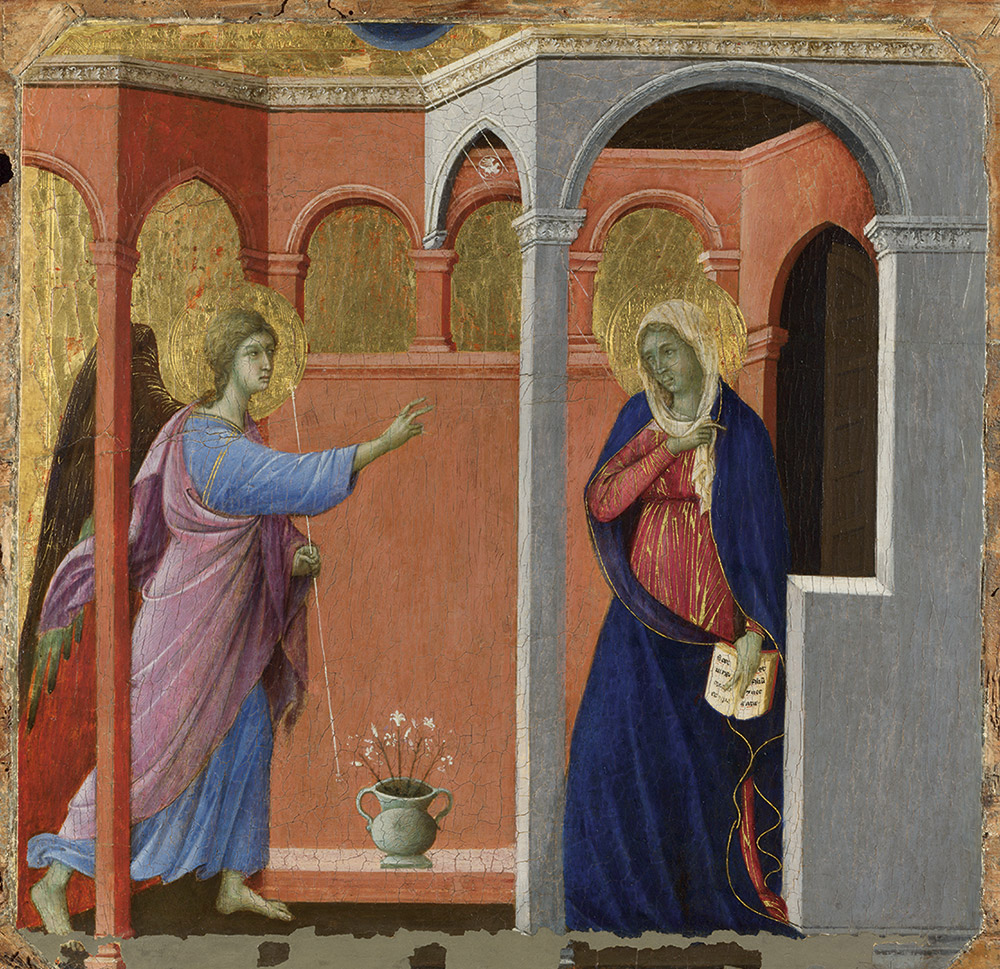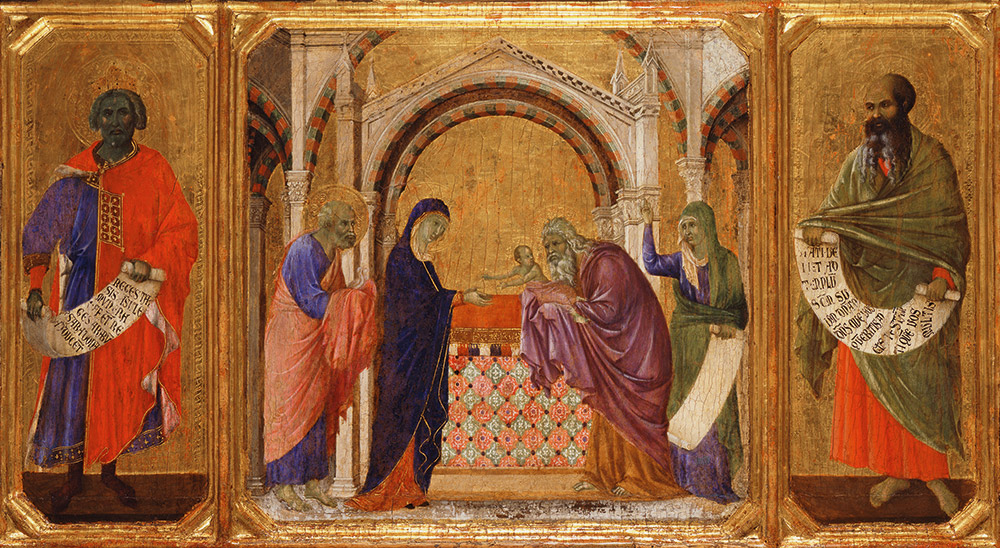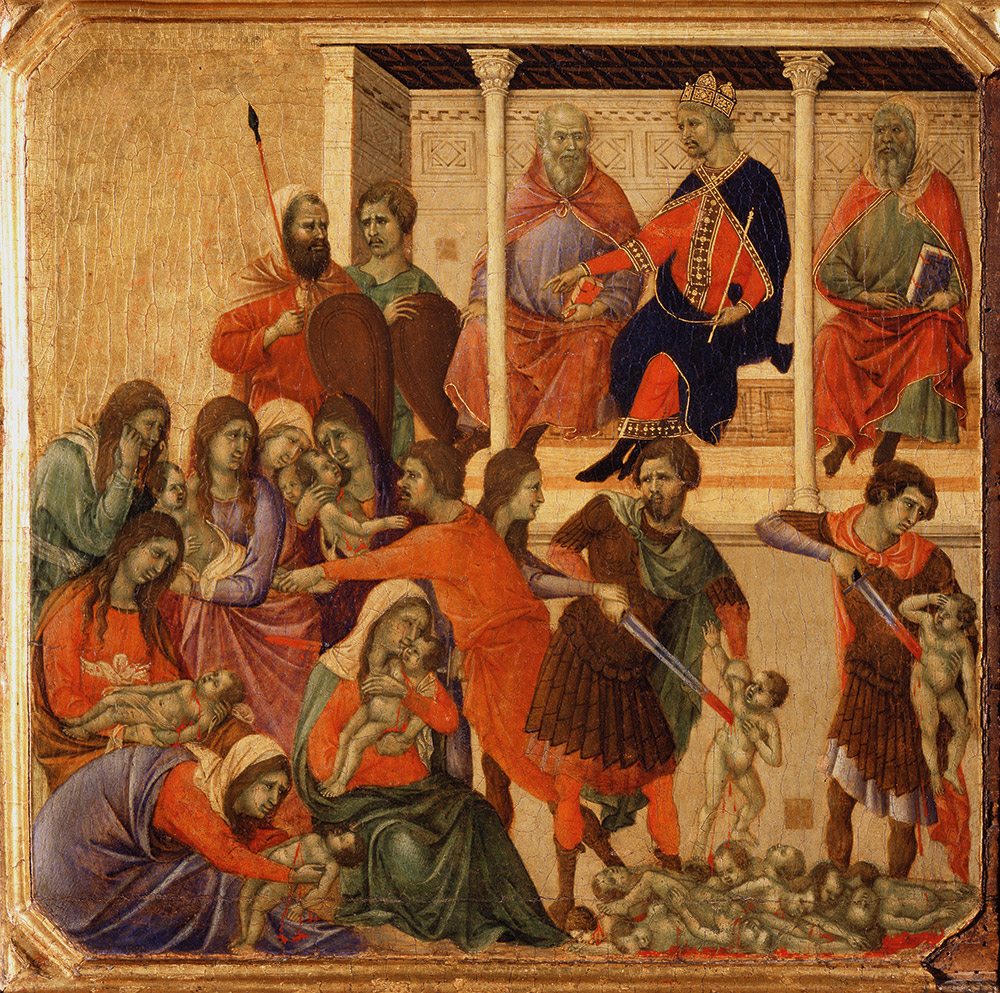The Nativity is flanked by the full-length figures of the two prophets who foretell the birth of Christ [fig. 1] [fig. 1] Detail of Ezekiel, Duccio di Buoninsegna, The Nativity with the Prophets Isaiah and Ezekiel, 1308–1311, tempera on poplar, National Gallery of Art, Washington, Andrew W. Mellon Collection [fig. 2]
[fig. 1] Detail of Ezekiel, Duccio di Buoninsegna, The Nativity with the Prophets Isaiah and Ezekiel, 1308–1311, tempera on poplar, National Gallery of Art, Washington, Andrew W. Mellon Collection [fig. 2] [fig. 2] Detail of Isaiah, Duccio di Buoninsegna, The Nativity with the Prophets Isaiah and Ezekiel, 1308–1311, tempera on poplar, National Gallery of Art, Washington, Andrew W. Mellon Collection. Isaiah, to the left, as revealed by the text of his scroll and his leftward-turned gaze, is thematically linked to the previous scene of the front predellaA horizontal band, cut from a single plank, below the main panels of an altarpiece. The appearance of the predella can be seen as part of the development of the altarpiece from a single panel to a large, multilevel polyptych. The small figures or scenes painted on the predella formed part of the integrated program of the altarpiece, providing a visual commentary on the major images above and at the same time physically raising the main panels, thus improving their visibility.
—Ronald Baxter, Grove Art © Oxford University Press, representing the Annunciation [fig. 3] [fig. 3] Duccio di Buoninsegna, The Annunciation, 1308–1311, tempera on panel, The National Gallery, London. © National Gallery, London/Art Resource, NY, now in the National Gallery of London. The iconographyTerms that refer broadly to the study of subjects and themes in works of art. Iconology, which is based on the results of iconography, is the more wide-ranging and comprehensive. One of the principal concerns of iconography is the discovery of symbolic and allegorical meanings in a work of art.
—Willem F. Lash, Grove Art © Oxford University Press of the Nativity follows the figurative tradition of Byzantine art, combining the scene with the subsidiary episodes of the Glad Tidings to the Shepherds and the First Bath of the Child. Mary is shown semirecumbent on a mattress inside the cave setting, into which a simple wooden hut with sloping roof is inserted. At the center of the hut, in the background, we see the manger with the child and two animals. In the foreground the episode of the First Bath occupies a central position, with the two midwives portrayed in slightly smaller proportions than the Madonna. To the left we see Saint Joseph seated on a rock, sunk in meditation, while to the right appear the two shepherds conversing with one of the fourteen angels that throng the upper part of the scene.
[fig. 2] Detail of Isaiah, Duccio di Buoninsegna, The Nativity with the Prophets Isaiah and Ezekiel, 1308–1311, tempera on poplar, National Gallery of Art, Washington, Andrew W. Mellon Collection. Isaiah, to the left, as revealed by the text of his scroll and his leftward-turned gaze, is thematically linked to the previous scene of the front predellaA horizontal band, cut from a single plank, below the main panels of an altarpiece. The appearance of the predella can be seen as part of the development of the altarpiece from a single panel to a large, multilevel polyptych. The small figures or scenes painted on the predella formed part of the integrated program of the altarpiece, providing a visual commentary on the major images above and at the same time physically raising the main panels, thus improving their visibility.
—Ronald Baxter, Grove Art © Oxford University Press, representing the Annunciation [fig. 3] [fig. 3] Duccio di Buoninsegna, The Annunciation, 1308–1311, tempera on panel, The National Gallery, London. © National Gallery, London/Art Resource, NY, now in the National Gallery of London. The iconographyTerms that refer broadly to the study of subjects and themes in works of art. Iconology, which is based on the results of iconography, is the more wide-ranging and comprehensive. One of the principal concerns of iconography is the discovery of symbolic and allegorical meanings in a work of art.
—Willem F. Lash, Grove Art © Oxford University Press of the Nativity follows the figurative tradition of Byzantine art, combining the scene with the subsidiary episodes of the Glad Tidings to the Shepherds and the First Bath of the Child. Mary is shown semirecumbent on a mattress inside the cave setting, into which a simple wooden hut with sloping roof is inserted. At the center of the hut, in the background, we see the manger with the child and two animals. In the foreground the episode of the First Bath occupies a central position, with the two midwives portrayed in slightly smaller proportions than the Madonna. To the left we see Saint Joseph seated on a rock, sunk in meditation, while to the right appear the two shepherds conversing with one of the fourteen angels that throng the upper part of the scene.
The painting was the second of seven scenes ([fig. 4] [fig. 4] Duccio di Buoninsegna, The Adoration of the Magi, 1308–1311, tempera on panel, Museo dell'Opera del Duomo, Siena. Image: Soprintendenza per le Belle Arti e il Paesaggio di Siena, Grosseto ed Arezzo [fig. 5] [fig. 5] Duccio di Buoninsegna, Christ among the Doctors, 1308–1311, tempera on panel, Museo dell'Opera del Duomo, Siena. Image: Soprintendenza per le Belle Arti e il Paesaggio di Siena, Grosseto ed Arezzo [fig. 6] [fig. 6] Duccio di Buoninsegna, The Massacre of the Innocents, 1308–1311, tempera on panel, Museo dell'Opera del Duomo, Siena. Image: Soprintendenza per le Belle Arti e il Paesaggio di Siena, Grosseto ed Arezzo [fig. 7] [fig. 7] Duccio di Buoninsegna, The Presentation in the Temple with Salomon (or David?) and the Prophet Malachi, 1308–1311, tempera on panel, Museo dell'Opera del Duomo, Siena. Image: Soprintendenza per le Belle Arti e il Paesaggio di Siena, Grosseto ed Arezzo [fig. 8] [fig. 8] Duccio di Buoninsegna, The Flight into Egypt with the Prophets Jeremiah and Hosea, 1308–1311, tempera on panel, Museo dell'Opera del Duomo, Siena. Image: Soprintendenza per le Belle Arti e il Paesaggio di Siena, Grosseto ed Arezzo) interspersed with standing figures of prophets that formed the predella of the front side of the two-sided altarpieceAn image-bearing structure set on the rear part of the altar, abutting the back of the altarblock, or set behind the altar in such a way as to be visually joined with the altar when viewed from a distance. It is also sometimes called a retable, following the medieval term retrotabulum. The altarpiece was never officially prescribed by the Church, but it did perform a prescribed function alternatively carried out by a simple inscription on the altarblock: to declare to which saint or mystery the altar was dedicated. In fact, the altarpiece did more than merely identify the altar; its form and content evoked the mystery or personage whose cult was celebrated at the altar. This original and lasting function influenced the many forms taken by the altarpiece throughout its history.
—Alexander Nagel, Grove Art © Oxford University Press placed over the high altar in Siena Cathedral [fig. 9] [fig. 9] Reconstruction of the front of the predella of Duccio di Buoninsegna's Maestà: a. The Annunciation (fig. 3); b. The Nativity with the Prophets Isaiah and Ezekiel; c. The Adoration of the Magi (fig. 4); d. The Presentation in the Temple with Salomon (or David?) and the Prophet Malachi (fig. 7); e. The Massacre of the Innocents (fig. 6); f. The Flight into Egypt with the Prophets Jeremiah and Hosea (fig. 8); g. Christ among the Doctors (fig. 5) (see also Reconstruction). For a discussion of the multipart complex of which this work has always been recognized as an integral part, see the entry on The Calling of the Apostles Peter and Andrew.
Miklós Boskovits (1935–2011)
March 21, 2016



















